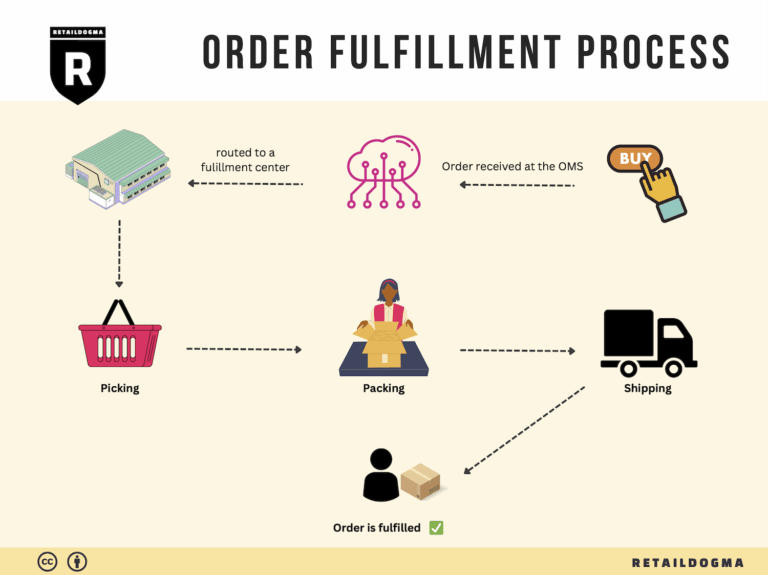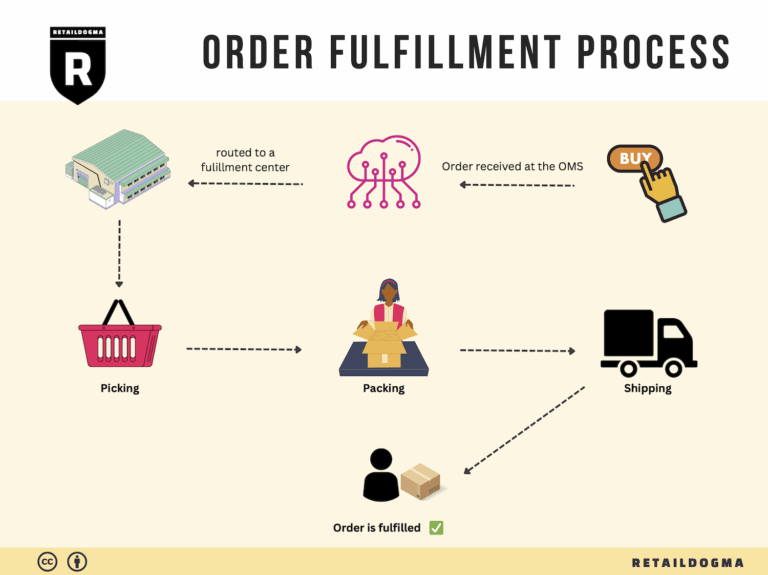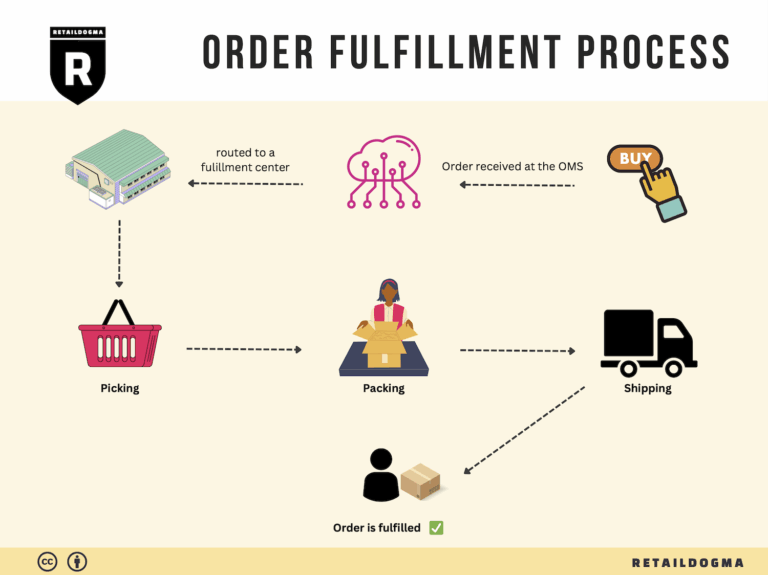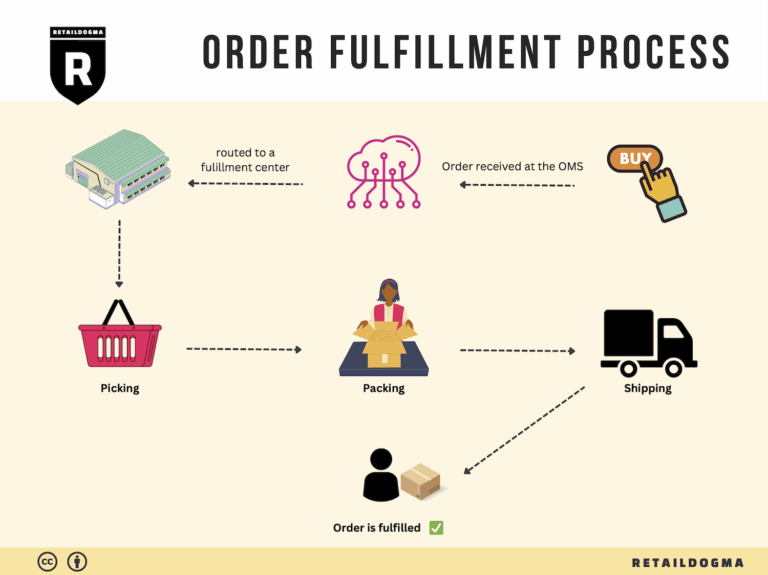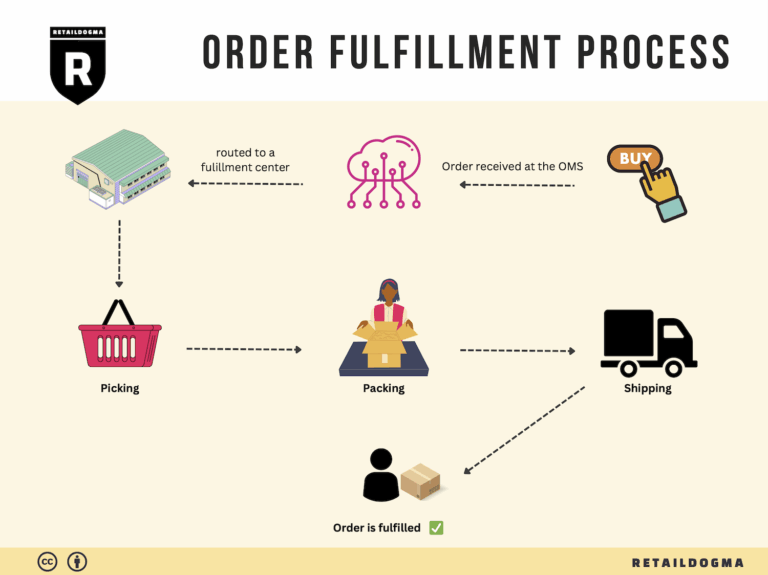What Is A Fulfillment Center? A Complete Guide (2025)
What is E-commerce Fulfillment? An Introduction for Growing Businesses
Navigating the Complex World of E-commerce Fulfillment
As an e-commerce business owner, you may find yourself grappling with the daunting task of packing and shipping orders. While the excitement of growing sales is palpable, the logistics of fulfilling these orders can quickly become overwhelming. From managing inventory and ensuring timely delivery to maintaining customer satisfaction, the fulfillment process can feel like a never-ending cycle of stress.
E-commerce fulfillment is fundamentally the process of getting a product from your business to your customer’s doorstep. This includes everything from storing your inventory, picking and packing orders, to shipping them out. Understanding this process is crucial for scaling your business efficiently and effectively.
In this guide, we will explore various fulfillment models that can support your growth. We’ll delve into traditional third-party logistics (3PL) providers, Amazon’s Fulfillment by Amazon (FBA), and other innovative solutions that can streamline your operations. Each of these options has its own set of advantages and challenges, and knowing which one aligns with your business goals is key to successful scaling.
We will also cover the core services involved in e-commerce fulfillment, including inventory management, order processing, shipping, and returns handling. Understanding these services will help you identify what you need from a fulfillment partner and how they can support your specific requirements.
Choosing the right fulfillment partner is another critical decision that can impact your business’s success. We will provide practical tips on what to look for in a partner, including their capabilities, technology integration, and customer service. With the right partner, you can offload the logistics burden and focus on what you do best—growing your business.
Lastly, pricing is an essential aspect of fulfillment that can significantly affect your bottom line. We will break down common pricing structures and help you understand the factors that contribute to costs, allowing you to make informed decisions that align with your financial goals.
The goal of this guide is to empower e-commerce businesses like yours to make smart, strategic decisions about your logistics. By understanding the complexities of e-commerce fulfillment, you can optimize your operations, enhance customer satisfaction, and ultimately drive growth in your business.

What You’ll Learn In This Guide
- What is E-commerce Fulfillment? An Introduction for Growing Businesses
- The Order Fulfillment Process: From ‘Buy’ Button to Customer’s Door
- Comparing Fulfillment Models: In-House vs. 3PL vs. Dropshipping
- A Deep Dive into Amazon FBA: Pros, Cons, and Who It’s For
- Core Services Offered by Fulfillment Centers
- How to Choose a Fulfillment Partner: A 6-Point Checklist
- Understanding Fulfillment Pricing: A Breakdown of Common Fees
- Frequently Asked Questions (FAQs) about Fulfillment
- Conclusion: Is Outsourcing Fulfillment the Right Move for Your Business?
- Important Disclaimer
The Order Fulfillment Process: From ‘Buy’ Button to Customer’s Door
1. Receiving Inventory
The order fulfillment process begins with the receiving of inventory at the fulfillment center. This step is crucial as it establishes the foundation for your stock management and overall efficiency. When products arrive, they are checked against purchase orders to ensure that the correct items and quantities have been delivered. This process often involves scanning items using their Stock Keeping Unit (SKU) codes, which are unique identifiers for each product.
Proper inventory receiving helps prevent discrepancies that could lead to stockouts or overstock situations. It is vital to maintain accurate records from the outset, as this will influence inventory accuracy and customer satisfaction down the line. Efficient receiving processes can include automated systems that update inventory levels in real-time, ensuring that your e-commerce platform reflects accurate stock availability.
2. Warehouse Storage
Once inventory is received, it is stored in the fulfillment center. This step involves organizing products in a way that maximizes space and facilitates easy access. Effective warehouse management uses various strategies, such as FIFO (First In, First Out) to ensure that older stock is sold before newer arrivals, minimizing the risk of obsolescence.
The layout of the warehouse is also critical; items are often categorized by size, type, or sales velocity, which helps in optimizing the picking process later. By employing a systematic approach to storage, businesses can enhance their operational efficiency. The key term here is “bin locations,” which refers to the designated spots within the warehouse where products are stored, making retrieval straightforward for warehouse staff.
3. Order Picking
The next step in the order fulfillment process is order picking, where items are selected from their storage locations based on customer orders. This phase is vital, as it directly impacts order accuracy and fulfillment speed. Order pickers utilize “pick lists,” which are detailed lists of items required for each order, to streamline the process.
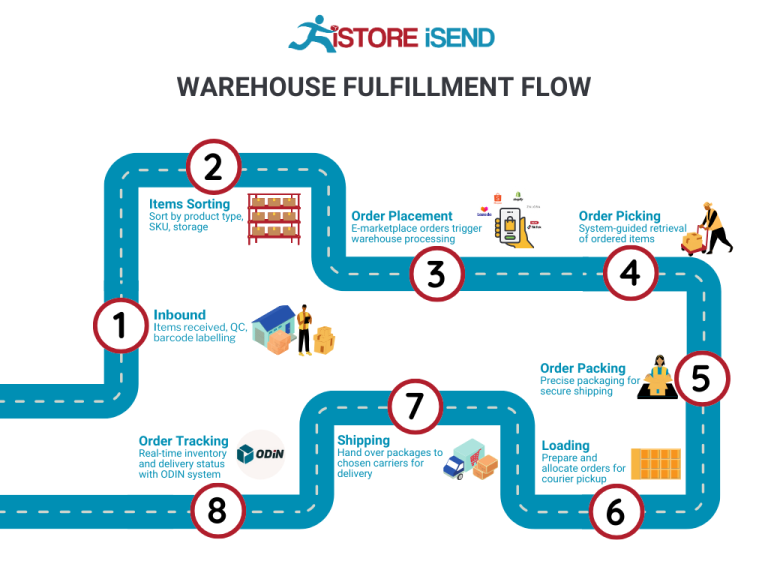
There are various picking methods, such as single order picking, batch picking, and zone picking, each suited for different operational needs. The chosen method can significantly affect efficiency and labor costs. For instance, batch picking allows multiple orders to be picked at once, reducing the number of trips made within the warehouse. Ensuring accuracy during this step is crucial, as errors can lead to returns, refunds, and dissatisfied customers.
4. Order Packing
After the items are picked, they are taken to the packing station. This step involves securely packaging the products to ensure they arrive at the customer’s doorstep in perfect condition. Packing materials, such as boxes, cushioning, and tape, are selected based on the nature of the products being shipped.
Effective packing is not only about protection; it also involves optimizing the size of the package to reduce shipping costs. Using the right packaging can lead to savings in shipping fees and help maintain a sustainable approach by minimizing excess waste. The key term here is “packaging optimization,” which focuses on balancing product safety with cost-effectiveness in shipping. A well-executed packing process can enhance the customer experience, as well-packaged items often lead to positive feedback and repeat business.
5. Shipping & Delivery
The final step in the order fulfillment process is shipping and delivery. Once orders are packed, they are labeled and handed over to shipping carriers for delivery. This step is crucial for customer satisfaction, as timely delivery can make or break the customer experience. Businesses often choose shipping options based on their agreements with carriers, customer preferences, and delivery timelines.
Monitoring shipping performance is essential; companies should track key metrics such as “on-time delivery rates” and “shipping accuracy.” Utilizing technology for real-time tracking allows customers to stay informed about their order status, enhancing transparency and trust. Additionally, integrating shipping solutions with e-commerce platforms can streamline the process, allowing for automated updates and better customer communication. Efficient shipping practices can ultimately enhance your brand’s reputation and drive customer loyalty.
In summary, understanding and optimizing each step of the order fulfillment process is essential for e-commerce business owners and operations managers looking to scale effectively. By mastering the intricacies of receiving inventory, warehouse storage, order picking, packing, and shipping, businesses can significantly improve their operational efficiency and customer satisfaction.
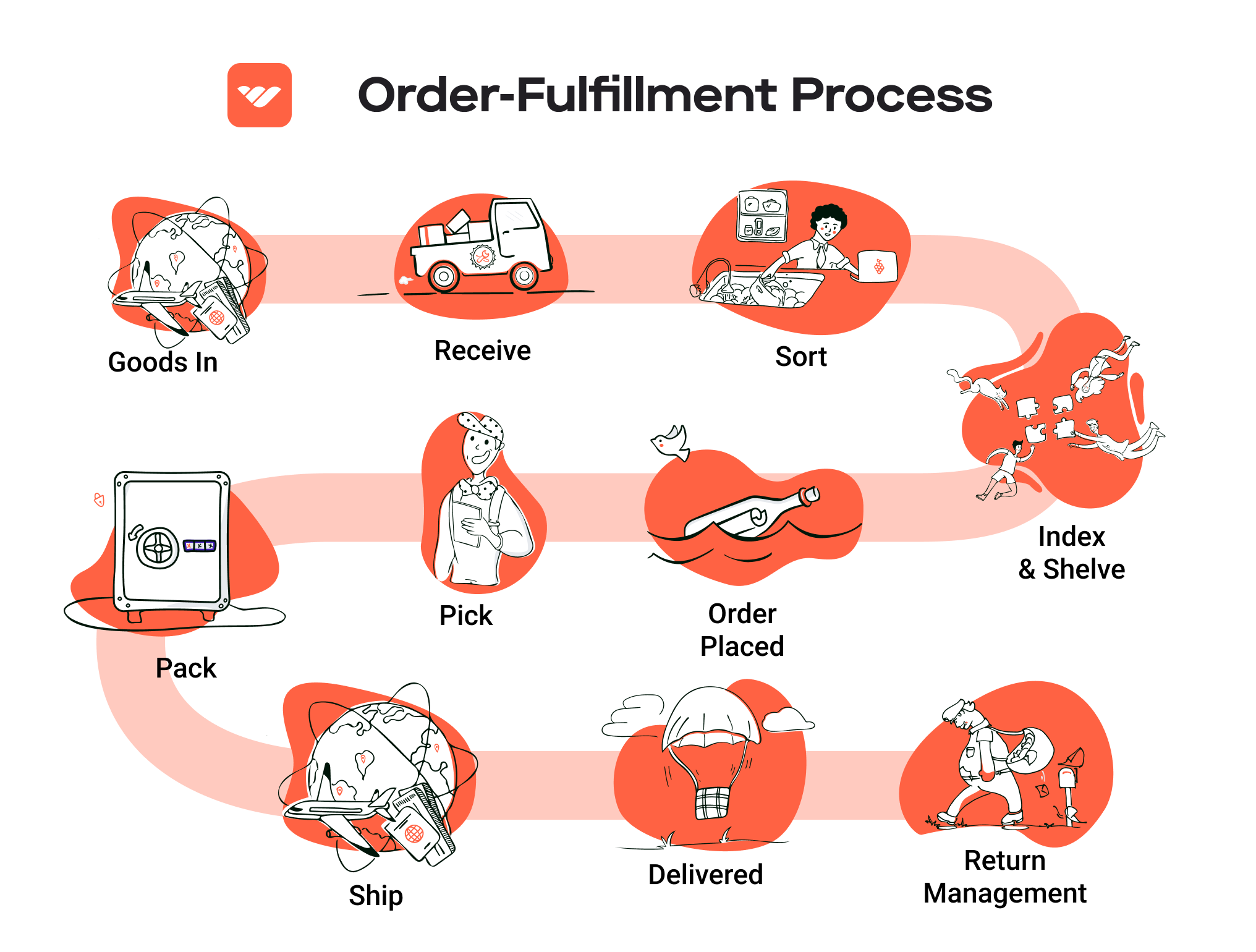
Comparing Fulfillment Models: In-House vs. 3PL vs. Dropshipping
Fulfillment Models Overview
When it comes to scaling e-commerce businesses, choosing the right fulfillment model is critical. Each model comes with its unique set of advantages and disadvantages that can significantly impact your operations, customer satisfaction, and overall profitability. Below is a comparison of the three main fulfillment models: In-House Fulfillment, Third-Party Logistics (3PL), and Dropshipping.
| Model | Who Handles Inventory | Best For (Business Stage) | Key Advantage | Key Disadvantage |
|---|---|---|---|---|
| In-House Fulfillment | Business owns and manages inventory | Startups to established businesses | Complete control over inventory and processes | High overhead costs and resource-intensive |
| Third-Party Logistics (3PL) | 3PL provider manages inventory | Growth-stage businesses and scaling e-commerce | Scalability and reduced operational burden | Less control over inventory and potential communication issues |
| Dropshipping | Supplier ships directly to customer | Startups and small businesses | Low overhead and no inventory risk | Lower margins and reliance on supplier reliability |
In-House Fulfillment
In-house fulfillment refers to the model where a business manages its own inventory, warehousing, and shipping processes. This model is often adopted by startups that want complete control over their operations and customer experience. By handling everything in-house, businesses can customize their fulfillment processes, which can be a significant advantage when it comes to brand representation and customer service.
One of the key benefits of in-house fulfillment is the ability to maintain direct oversight over inventory management and order fulfillment. This means you can implement tailored processes that align with your brand’s values and customer expectations. However, it also comes with considerable downsides. The overhead costs can be high due to warehousing expenses, staffing, and the need for a logistics management system. Additionally, as the business scales, managing logistics in-house can become increasingly resource-intensive and complex, leading to potential inefficiencies.
Third-Party Logistics (3PL)
Third-party logistics (3PL) involves outsourcing fulfillment operations to a specialized logistics provider. This model is particularly beneficial for growth-stage businesses that are looking to scale quickly without the burden of managing logistics themselves. 3PL providers like Amazon Fulfillment Centers can handle everything from warehousing to packing and shipping, allowing businesses to focus on their core competencies.
The primary advantage of using a 3PL is scalability. As your sales volume increases, a 3PL can easily accommodate additional orders without the need for significant capital investment in infrastructure. Moreover, many 3PLs offer advanced technology and reporting tools that can enhance visibility into inventory and order status. However, the trade-off is that businesses may have less control over inventory and fulfillment processes, which can lead to communication challenges. Additionally, relying on a third party means that any issues with their operations can directly impact your customer satisfaction.
Dropshipping
Dropshipping is a fulfillment model where the retailer does not keep goods in stock but instead transfers customer orders and shipment details to a supplier who ships the products directly to the customer. This model is particularly appealing for startups and small businesses due to its low overhead and minimal inventory risk.
One of the most significant advantages of dropshipping is the ability to launch a business without the need for significant upfront investment in inventory. This allows entrepreneurs to test different products and markets with limited financial exposure. However, dropshipping also has its challenges. Margins tend to be lower compared to traditional fulfillment models, and businesses are heavily reliant on suppliers for product quality and shipping reliability. Any delays or issues on the supplier’s end can reflect poorly on your brand, leading to customer dissatisfaction.
Conclusion
Choosing the right fulfillment model is a crucial decision that can impact your e-commerce business’s efficiency and scalability. In-house fulfillment offers control but at a higher cost and resource requirement. Third-party logistics provide scalability and reduced operational burden but may come with less control and potential communication issues. Finally, dropshipping allows for low-risk entry into the market but often results in lower margins and reliance on supplier reliability. Each model has its place, and the best choice will depend on your specific business needs, growth stage, and operational capabilities.
A Deep Dive into Amazon FBA: Pros, Cons, and Who It’s For
What is Fulfillment by Amazon (FBA)?
Fulfillment by Amazon (FBA) is a service provided by Amazon that allows sellers to store their products in Amazon’s fulfillment centers. Amazon then takes care of storage, packaging, shipping, and customer service for these products. This service enables sellers to leverage Amazon’s vast logistics network and customer service capabilities, which can significantly enhance their reach and operational efficiency.
When a customer places an order for a product fulfilled by Amazon, the order is processed through Amazon’s systems. The product is picked from the inventory in the fulfillment center, packed, and shipped directly to the customer. Amazon also handles returns and customer inquiries related to these orders. This seamless integration allows sellers to focus on growing their business while Amazon manages the complexities of logistics.
How FBA Works
-
Set Up Your FBA Account: To begin using FBA, sellers must create an Amazon seller account and enroll in FBA.
-
Prepare Your Products: Sellers need to ensure their products meet Amazon’s preparation and packaging requirements. This includes labeling products with unique barcodes and ensuring they are packaged correctly for shipping.
-
Ship Inventory to Amazon: Sellers send their inventory to Amazon’s fulfillment centers. Amazon has multiple centers across the U.S., including one in Charlotte, NC, which enhances shipping efficiency due to its strategic location.
-
Product Storage: Once the inventory is received, it is stored in Amazon’s warehouse. Amazon manages inventory levels and provides sellers with real-time data on stock levels.
-
Order Fulfillment: When a customer places an order, Amazon picks, packs, and ships the product directly to the customer. This process is often completed within 24 hours, allowing for quick delivery.
-
Customer Service and Returns: Amazon handles all customer service inquiries related to FBA orders, including returns and refunds, which alleviates a significant burden from sellers.
Pros of FBA
-
Prime Eligibility: Products fulfilled by Amazon are eligible for Amazon Prime, which provides sellers with access to millions of Prime members who are more likely to purchase items with faster shipping options.
-
Customer Trust: Leveraging Amazon’s brand reputation increases customer trust. Shoppers are more likely to buy from a seller using FBA due to Amazon’s reliable shipping and customer service.
-
Multi-Channel Fulfillment: FBA allows sellers to fulfill orders not just from Amazon but from other sales channels as well. This means sellers can use Amazon’s logistics for orders placed on their own websites or other marketplaces, streamlining their operations.
-
Scalability: FBA allows sellers to scale their businesses quickly without needing to invest heavily in logistics infrastructure. As demand increases, sellers can send more inventory to Amazon without worrying about warehousing or shipping logistics.
-
Time Savings: Outsourcing fulfillment to Amazon saves sellers significant time and effort, allowing them to focus on marketing, product development, and other critical business areas.
Cons of FBA
-
High Fees: FBA comes with various fees, including storage fees for products stored in Amazon’s warehouses and fulfillment fees for each order shipped. These costs can add up, particularly for sellers with low-margin products.
-
Strict Inventory Rules: Amazon has strict guidelines regarding inventory management, including limitations on the amount of inventory that can be stored and requirements for labeling. Failure to comply can lead to additional fees or removal of products from the platform.
-
Commingling Risks: FBA products may be commingled with inventory from other sellers, which can pose risks. If a customer returns a defective item, it may be difficult for sellers to track down the specific inventory that caused the issue, potentially affecting seller ratings.
-
Loss of Control: By outsourcing fulfillment, sellers relinquish some control over the fulfillment process. This can lead to inconsistencies in packaging and customer service, which may not align with a seller’s brand image.
-
Limited Customization: Amazon’s fulfillment process is standardized, which means sellers have limited options for customizing packaging or including promotional materials in their shipments.
Who is FBA Best For?
Fulfillment by Amazon is ideal for e-commerce businesses that want to scale quickly without the overhead of managing their own logistics. It is particularly beneficial for:
-
Small to Medium-Sized Businesses: Companies that lack the resources to manage warehousing and logistics can take advantage of FBA’s infrastructure.
-
High-Volume Sellers: Businesses that have a steady stream of orders and can benefit from Amazon’s shipping efficiency will find FBA advantageous.
-
New Sellers: Entrepreneurs just starting out can leverage Amazon’s established customer base and fulfillment capabilities to enter the market more effectively.
-
Sellers with Seasonal Products: Businesses that experience fluctuating demand can use FBA to manage inventory without the long-term commitment of traditional warehousing.
-
Multi-Channel Sellers: Brands that sell across various platforms can streamline their operations by utilizing FBA for all order fulfillment, enhancing efficiency and customer service.
In conclusion, while FBA offers significant advantages such as access to Amazon’s vast customer base and logistics network, it also comes with challenges that sellers must carefully consider. Understanding these pros and cons will help e-commerce business owners make informed decisions about whether FBA aligns with their operational goals.
Core Services Offered by Fulfillment Centers
Inventory Management & Warehousing
Inventory management and warehousing are foundational services provided by fulfillment centers. This involves the systematic control of inventory levels, ensuring that products are stored efficiently and accurately. Fulfillment centers utilize advanced inventory management systems that track stock levels in real-time, providing e-commerce businesses with visibility into their inventory status.
The benefits of effective inventory management are manifold. Firstly, it helps prevent stockouts and overstock situations, which can lead to lost sales or increased holding costs. A well-organized warehouse allows for optimal storage space utilization, reducing operational costs. Furthermore, accurate inventory records enable better forecasting and demand planning, allowing businesses to respond swiftly to market trends and customer needs. In a competitive e-commerce environment, maintaining the right inventory levels can significantly enhance customer satisfaction and loyalty.
Pick and Pack Services
Pick and pack services are crucial for ensuring that orders are fulfilled accurately and efficiently. This process involves selecting items from the warehouse shelves (picking) and then assembling them into packages for shipping (packing). Fulfillment centers often employ automated systems and technologies such as barcode scanning to streamline this process, reducing the likelihood of errors.
The primary advantage of pick and pack services is the speed and accuracy they bring to order fulfillment. Fast and precise order processing is essential for e-commerce businesses that rely on quick delivery to meet customer expectations. By outsourcing this function to a fulfillment center, businesses can scale their operations without investing in additional labor or infrastructure. This allows them to focus on core business activities, such as marketing and product development, while ensuring that their customers receive the right products promptly.
Kitting and Assembly
Kitting and assembly services involve the grouping of individual items into ready-to-ship sets or kits. This could include anything from bundling complementary products together, such as a camera with a lens and a case, to assembling complex products that require multiple components. Fulfillment centers can manage these processes efficiently, ensuring that products are packaged correctly and meet quality standards before they are shipped.
The benefits of kitting and assembly services are significant for e-commerce businesses looking to enhance their product offerings. By providing bundled products, businesses can increase average order values and create more compelling offers for customers. Additionally, kitting can streamline the fulfillment process by reducing the number of individual items that need to be picked and packed, thereby increasing operational efficiency. This service also allows businesses to offer unique product combinations that may not be available through traditional retail channels, setting them apart from competitors.
Returns Management (Reverse Logistics)
Returns management, or reverse logistics, is an essential service offered by fulfillment centers that deals with the handling of returned items. This process includes receiving returned products, inspecting them, restocking, or processing them for disposal or recycling. Effective returns management is critical for maintaining customer satisfaction and loyalty in the e-commerce space.
The benefits of having a robust returns management system in place are profound. First, it helps e-commerce businesses to efficiently process returns, ensuring that customers receive timely refunds or exchanges. A seamless returns experience can enhance customer trust and encourage repeat purchases. Furthermore, fulfillment centers can analyze return data to identify patterns and address the underlying causes of returns, such as product quality issues or misleading descriptions. By optimizing the returns process, businesses can not only reduce costs associated with returns but also improve overall customer experience, fostering long-term loyalty.
Conclusion
In conclusion, the core services offered by fulfillment centers—inventory management and warehousing, pick and pack services, kitting and assembly, and returns management—are crucial for the success of e-commerce businesses. Each service provides unique benefits that contribute to operational efficiency, customer satisfaction, and ultimately, business growth. By leveraging these services, e-commerce entrepreneurs can focus on scaling their sales while ensuring that their logistics operations are handled with expertise and precision. As the e-commerce landscape continues to evolve, partnering with a capable fulfillment center will be key to staying competitive and meeting customer expectations.
How to Choose a Fulfillment Partner: A 6-Point Checklist
Location & Warehouse Network
Importance: The geographic location of your fulfillment partner’s warehouses can significantly impact shipping times and costs. A strategically placed fulfillment center, like the Amazon Fulfillment Center in Charlotte, NC, can facilitate faster delivery to key markets, especially if your customer base is concentrated in the Southeast.
Questions to Ask:
– What are the locations of your fulfillment centers, and how do they align with my customer distribution?
– Do you have plans to expand your warehouse network in the near future?
– How does your location affect shipping times and costs for both ground and expedited services?
Technology & Integrations
Importance: Efficient fulfillment operations rely heavily on technology. A fulfillment partner should provide robust technology solutions for inventory management, order tracking, and integration with your existing e-commerce platforms. This is crucial for maintaining visibility throughout the supply chain and ensuring seamless operations.
Questions to Ask:
– What order management system (OMS) do you use, and how does it integrate with major e-commerce platforms like Amazon, Shopify, or WooCommerce?
– Can your system provide real-time tracking and inventory updates?
– Are there any additional fees for technology integrations or upgrades?
Specializations (e.g., Cold Storage, Oversized Items)
Importance: Depending on your product offerings, you may require specific handling capabilities. If you sell perishable goods, for instance, you’ll need a partner with cold storage facilities. Alternatively, if you deal with oversized items, ensure that your partner can accommodate these without incurring excessive fees or delays.
Questions to Ask:
– Do you have specialized facilities for handling specific types of products (e.g., cold storage, fragile items, oversized goods)?
– What processes do you have in place to ensure the safe handling and storage of these items?
– Can you provide case studies or references for businesses with similar needs?
Scalability & Capacity
Importance: As your business grows, your fulfillment needs will change. Choosing a partner that can scale operations to meet increasing demand is critical. This includes having the capacity to handle seasonal spikes, new product launches, or expansion into new markets.
Questions to Ask:
– What is your current capacity, and how do you handle peak seasons?
– How quickly can you scale up operations if my order volume increases significantly?
– Are there any limitations on the types of products or volumes you can handle as we grow?
Pricing and Contracts
Importance: Understanding the pricing structure is essential to ensure that you can maintain healthy margins while meeting customer expectations. Look for transparency in pricing, including any additional fees for services like storage, picking, packing, and shipping.
Questions to Ask:
– Can you provide a detailed breakdown of your pricing model?
– Are there any hidden fees or surcharges I should be aware of?
– What is the length of the contract, and what are the terms for termination or renegotiation?
Customer Support & Reviews
Importance: Reliable customer support can make a significant difference in how smoothly your operations run. A partner that is responsive and proactive in addressing issues can help mitigate potential disruptions in your supply chain. Additionally, checking reviews can provide insight into their performance and reliability.
Questions to Ask:
– What level of customer support do you offer, and how can I reach your support team?
– Can you provide references or case studies from current clients?
– What is your track record for order accuracy and on-time delivery?
Conclusion
Choosing the right fulfillment partner is crucial for the success of your e-commerce business. By using this checklist, you can systematically evaluate potential partners based on their location, technology capabilities, specializations, scalability, pricing, and customer support. Make informed decisions that align with your business goals and customer expectations, ensuring a smooth and efficient fulfillment process as you scale your operations.
Understanding Fulfillment Pricing: A Breakdown of Common Fees
Initial Setup Fees
When partnering with a fulfillment center, the initial setup fee is often the first cost you encounter. This fee typically covers the onboarding process, which includes account creation, integration with your e-commerce platform, and any necessary training for your team on the fulfillment system. The fee can vary widely based on the complexity of your operations and the technology used by the fulfillment center.
Calculation: Initial setup fees are usually a one-time charge and can range from a few hundred to several thousand dollars. It’s essential to clarify what is included in this fee and whether any additional costs might arise if your needs change during the onboarding process.
Receiving Fees
Receiving fees are charged when the fulfillment center receives your inventory. This fee accounts for the labor and resources involved in unloading, inspecting, and storing your products. Efficient receiving processes are crucial for maintaining inventory accuracy and ensuring that products are readily available for order fulfillment.
Calculation: Receiving fees are typically calculated on a per-unit basis or per hour of labor. For example, you might pay a flat fee for every 100 units received, or a fee based on the time spent unloading a shipment. Understanding the receiving process and potential costs can help you manage inventory more effectively.
Storage Fees (per pallet/bin)
Storage fees are incurred for the space your products occupy within the fulfillment center. This fee is essential for maintaining the physical storage of your inventory and can vary based on the size and type of your products. Most fulfillment centers charge based on either the number of pallets used or the amount of bin space occupied.
Calculation: Storage fees are typically charged monthly, with rates based on the space your inventory occupies. For instance, you may be charged a flat fee per pallet per month or a fee per cubic foot of space used. To optimize storage costs, it’s vital to regularly assess your inventory turnover and adjust your storage levels accordingly.
Pick & Pack Fees (per item/order)
Pick and pack fees cover the labor involved in retrieving items from storage and packaging them for shipment. This fee is critical for the fulfillment process, as it directly impacts the speed and accuracy of order delivery. The complexity of the pick and pack process can vary depending on the diversity and number of items in an order.
Calculation: These fees are generally charged per item or per order. For instance, you might pay a flat fee for the first item picked and an additional fee for each subsequent item. Some fulfillment centers offer tiered pricing based on order volume, which can benefit businesses with high order frequencies. Understanding the pick and pack pricing model is essential for projecting fulfillment costs accurately.
Shipping Fees
Shipping fees are among the most variable costs associated with fulfillment. These fees encompass the cost of transporting orders from the fulfillment center to your customers. Factors influencing shipping fees include the shipping method, package weight, dimensions, and destination.
Calculation: Shipping fees are usually based on carrier rates, which can vary significantly depending on the service level (e.g., standard vs. expedited shipping). Fulfillment centers may offer discounted shipping rates through partnerships with carriers, which can lower your overall shipping costs. Analyzing your shipping options and understanding the fee structure can help you optimize logistics and enhance customer satisfaction.
Tips for Getting an Accurate Quote
-
Define Your Needs Clearly: Before approaching fulfillment centers, outline your specific requirements, including inventory volume, order frequency, and product dimensions. This clarity will help centers provide more accurate quotes.
-
Request Detailed Pricing Models: Ask potential fulfillment partners for a comprehensive breakdown of their pricing structure, including any hidden fees or charges that may apply.
-
Compare Multiple Quotes: Don’t settle for the first quote you receive. Compare offers from several fulfillment centers to ensure you understand the market rates and services available.
-
Inquire About Discounts: Many fulfillment centers offer volume discounts or promotional rates for new clients. Inquire about potential savings based on your projected order volumes.
-
Consider Long-Term Partnerships: Establishing a long-term relationship with a fulfillment center can often lead to better pricing and service terms. Discuss potential long-term arrangements during your initial conversations.
By understanding these common fees and how they are calculated, you can make informed decisions that align with your business goals and optimize your fulfillment strategy.
Frequently Asked Questions (FAQs) about Fulfillment
1. What is the Amazon Fulfillment Center in Charlotte, NC?
The Amazon Fulfillment Center in Charlotte, NC, specifically the HCL1 facility, is a large-scale operation that manages the storage, packing, and shipping of products for Amazon’s e-commerce platform. This center plays a crucial role in Amazon’s supply chain, ensuring quick and efficient delivery of orders to customers across the country.
2. What services does the Amazon Fulfillment Center provide?
The Amazon Fulfillment Center provides a range of services, including inventory storage, order picking and packing, shipping, and returns processing. The facility is designed to handle high volumes of orders, allowing for rapid fulfillment and shipping, which is essential for maintaining customer satisfaction.
3. How does the fulfillment process work at Amazon?
At Amazon’s fulfillment centers, the process begins with receiving inventory from suppliers. Once the items are stored, they are picked when an order is placed. The selected items are then packed and labeled for shipping. Finally, packages are dispatched to various carrier services for delivery to customers, often within one to two days.
4. What’s the difference between a warehouse and a fulfillment center?
A warehouse primarily focuses on storing goods, while a fulfillment center is specifically designed to manage the process of fulfilling customer orders. Fulfillment centers include additional services such as inventory management, order processing, packing, and shipping, making them integral to e-commerce operations.
5. What is a 3PL (Third-Party Logistics)?
A 3PL, or third-party logistics provider, is a service that manages logistics and supply chain functions on behalf of businesses. This includes warehousing, fulfillment, transportation, and distribution services. Companies often use 3PLs to reduce operational costs and improve efficiency without investing in their own logistics infrastructure.
6. How much do fulfillment services cost?
Fulfillment service costs can vary based on several factors, including order volume, storage needs, and specific services required. Generally, costs may include storage fees, pick-and-pack fees, shipping charges, and any additional services like returns processing. It’s advisable to obtain quotes from various providers to find the best fit for your budget.
7. What are the benefits of using Amazon Fulfillment Centers?
Using Amazon Fulfillment Centers offers numerous benefits, including access to Amazon’s extensive distribution network, fast and reliable shipping options, and the ability to scale operations without the need for significant investment in infrastructure. Additionally, businesses can enhance their credibility by offering Amazon Prime shipping options to customers.
8. How can I integrate my e-commerce store with Amazon Fulfillment?
To integrate your e-commerce store with Amazon Fulfillment, you can use Amazon’s Fulfillment by Amazon (FBA) service. This involves setting up your Amazon seller account, sending your inventory to an Amazon fulfillment center, and using Amazon’s tools to manage your inventory and orders. Many e-commerce platforms offer plugins or APIs to facilitate this integration.
9. What types of products can be fulfilled at Amazon Fulfillment Centers?
Amazon Fulfillment Centers can handle a wide range of products, including consumer electronics, clothing, household goods, and more. However, there are restrictions on certain items, such as hazardous materials, perishables, and oversized items, which may require special handling or may not be accepted at all.
10. How can I ensure timely fulfillment from Amazon?
To ensure timely fulfillment from Amazon, maintain accurate inventory levels, regularly monitor your stock, and promptly send new inventory to the fulfillment center as needed. Utilizing Amazon’s tools and reports can help you manage your orders effectively, and setting realistic lead times will help manage customer expectations.
Conclusion: Is Outsourcing Fulfillment the Right Move for Your Business?
Evaluating the Benefits of Outsourcing Fulfillment
As an e-commerce business owner or operations manager, the decision to outsource fulfillment can significantly impact your operational efficiency and overall growth trajectory. Utilizing a fulfillment service, particularly one located strategically like the Amazon Fulfillment Center in Charlotte, NC, offers numerous advantages that can streamline your logistics and enhance customer satisfaction.
First and foremost, outsourcing fulfillment saves valuable time. By delegating the complexities of inventory management, packing, and shipping to specialized providers, you can redirect your focus toward core business activities such as marketing, product development, and customer engagement. This shift allows your team to work more efficiently, ultimately driving sales and fostering innovation.
Scalability is another crucial benefit. As your business grows, so do the demands of order fulfillment. Partnering with a fulfillment service allows you to easily scale your operations without the need for significant capital investment in warehouse space or staffing. Whether you’re experiencing seasonal spikes or consistent growth, a fulfillment partner can adjust to your needs, ensuring that you never miss an opportunity to serve your customers.
Moreover, leveraging the expertise of a fulfillment partner provides you with industry insights and best practices that might not be available in-house. These specialists are adept at navigating the complexities of logistics, compliance, and customer expectations, ensuring that your operations remain competitive.
However, the success of outsourcing fulfillment hinges on selecting the right partner. Conducting thorough research and due diligence is critical in finding a provider that aligns with your business goals and can accommodate your unique needs.
Call to Action
If you’re considering whether outsourcing fulfillment is the right move for your business, start by auditing your current shipping processes. Assess your operational pain points and growth aspirations, and determine if a fulfillment partner can help you achieve your objectives more effectively. Take the first step today—explore your options and position your business for sustained growth and success.
Important Disclaimer
⚠️ Important Disclaimer
The information in this guide is for educational purposes. Fulfillment services, pricing, and platform features change frequently. Always conduct your own due diligence and consult with providers directly before making business decisions.

